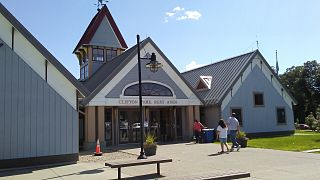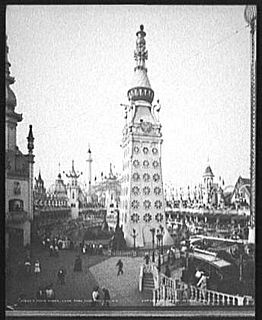
Clifton Park is a suburban town in Saratoga County, New York, United States. According to the United States Census Bureau, the 2010 population was 36,705. The name is derived from an early land patent. The town is in the south part of the county and is located approximately 12 miles (19 km) north of Albany, 7 miles (11 km) northeast of Schenectady, and 10 miles (16 km) south of Saratoga Springs.

An amusement park is a park that features various attractions, such as rides and games, as well as other events for entertainment purposes. A theme park is a type of amusement park that bases its structures and attractions around a central theme, often featuring multiple areas with different themes. Unlike temporary and mobile funfairs and carnivals, amusement parks are stationary and built for long-lasting operation. They are more elaborate than city parks and playgrounds, usually providing attractions that cater to a variety of age groups. While amusement parks often contain themed areas, theme parks place a heavier focus with more intricately-designed themes that revolve around a particular subject or group of subjects.

In the United States, trolley parks, which started in the 19th century, were picnic and recreation areas along or at the ends of streetcar lines in most of the larger cities. These were precursors to amusement parks. Trolley parks were often created by the streetcar companies to give people a reason to use their services on weekends.

Luna Park is a name shared by dozens of currently operating and defunct amusement parks. They are named after, and partly based on, the first Luna Park, which opened in 1903 during the heyday of large Coney Island parks. Luna parks are considered as small-scale attraction parks, easily accessed, potentially addressed to the permanent or temporary residential market, and located in the suburbs or even near the town center. Luna parks mainly offer classic funfair attractions, newer features and catering services.
Luna Park Melbourne is a historic amusement park located on the foreshore of Port Phillip Bay in St Kilda, Melbourne, Victoria. It opened on 13 December 1912, with a formal opening a week later, and has been operating almost continuously ever since.

Rexford is a hamlet in Saratoga County, New York, located on the north bank of the Mohawk River. Rexford is in the Town of Clifton Park, near the southwest town line. Its boundaries, like those of neighboring Alplaus, are unofficial and necessarily vague. To the south, it is bounded by the Mohawk River and Grooms Road and to the west, Alplaus and the Schenectady County line. Route 146 and Vischer's Ferry Road, are probably a reasonable delineations of its northern and eastern boundaries. The ZIP Code is 12148.

White City was an amusement park located in Shrewsbury, a suburb of Worcester, Massachusetts. It bordered Lake Quinsigamond and ran from 1905 to 1960.

Chutes Park in Los Angeles, California began as a trolley park in 1887. It was a 35-acre (140,000 m2) amusement park bounded by Grand Avenue on the west, Main Street on the east, Washington Boulevard on the north and 21st Street on the south. At various times it included rides, animal exhibits, a theater and a baseball park. In 1910 the park was sold to new owners and reopened as Luna Park. The amusement park closed in 1914.
Luna Park was a trolley park in Alexandria County, Virginia, that operated between 1906 and 1915. The Washington, Alexandria, and Mount Vernon Electric Railway constructed the amusement park for $350,000 in collaboration with the facility's designer and operator, Frederick Ingersoll.

Luna Park was a trolley park in Cleveland, Ohio, USA, from 1905 to 1929.

Council Crest Park is a city park in southwest Portland in the U.S. state of Oregon. Amenities include paved and unpaved paths, a dog off-leash area, picnic tables, public art, a view point, and a wedding site that can be reserved. The 43.51-acre (17.61 ha) park, operated by Portland Parks & Recreation, is open year-round from 5 a.m. to midnight. It was the site of an amusement park from 1907 until 1929.

Luna Park was an amusement park in the North Oakland section of Pittsburgh, Pennsylvania, USA, from 1905 to 1909. Constructed and owned by Frederick Ingersoll, the park occupied a 16 acre hilly site bounded by Baum Boulevard, North Craig Street, and Centre Avenue, and included roller coasters, picnic pavilions, carousels, a fun house, a Ferris wheel, a roller rink, a shoot-the-chutes ride, a concert shell, a dance hall, bumper cars, and a baby incubator exhibit. In its brief existence, the park featured regular performances of bands, acrobatic acts, animal acts, horse riders, and aerial acts.
Frederick Ingersoll was an American inventor, designer, builder and entrepreneur who created the world's first chain of amusement parks and whose manufacturing company built 277 roller coasters, fueling the popularity of trolley parks in the first third of the twentieth century. Some of these parks and roller coasters are still existing today.

Known by a variety of names over its 101-year existence, Rocky Glen Park was a park near Moosic, Pennsylvania. Founded by Arthur Frothingham in 1886 as a picnic park, it was transformed into an amusement park by engineer and entrepreneur Frederick Ingersoll in 1904. The trolley park was a popular Pennsylvania attraction that featured rides, arcades, and restaurants – even as a "wild west" theme park in the 1970s – until its closure in 1987.
Luna Park was an amusement park on the shore of Lake Ontario in Olcott Beach, New York, USA. A popular venue for live entertainment, it was open to the public from 1898 to 1926. The name of the dance hall and the inscription on the arch spanning the park's main entrance led to the commonly used nickname of "Dreamland."
Riverside Amusement Park was an amusement park in Indianapolis, Indiana, US from 1903 to 1970. Originating as a joint venture between engineer/amusement park developer Frederick Ingersoll and Indianapolis businessmen J. Clyde Power, Albert Lieber, Bert Fiebleman, and Emmett Johnson, the park was built by Ingersoll's Pittsburgh Construction Company adjacent to Riverside City Park at West 30th Street between White River and the Central Canal in the Riverside subdivision of Indianapolis.
Electric Park was a name shared by dozens of amusement parks in the United States that were constructed as trolley parks and owned by electric companies and streetcar companies. After 1903, the success of Coney Island inspired a proliferation of parks named Luna Park and Electric Park, while the World's Columbian Exposition of 1893 inspired the formation of White City amusement parks at roughly the same time. The existence of most of these parks was generally brief: the bulk of them closed by 1917, the year of the United States' entry into World War I. Many pavilions have outlasted the parks themselves, with a few of them still standing today.
White City is the common name of dozens of amusement parks in the United States, the United Kingdom, and Australia. Inspired by the White City and Midway Plaisance sections of the World's Columbian Exhibition of 1893, the parks started gaining in popularity in the last few years of the 19th century. After the 1901 Pan-American Exposition inspired the first Luna Park in Coney Island, a frenzy in building amusement parks ensued in the first two decades of the 20th century.

Electric Park was a 24-acre (97,000 m2) amusement park in Baltimore, Maryland, located near the intersection of Belvedere Avenue and Reisterstown Road. A trolley park that originally opened as a racetrack for harness racing, It opened in 1896, closed in 1915 and was razed in 1916. Electric Park's primary attractions were the thousands of light bulbs that shone at night. Admission to the park was free. The park was served by the North Avenue line of the United Railways and Electric Company for the duration of the park's existence.

Fort George Amusement Park was a trolley park and amusement park that operated in the Washington Heights and Inwood neighborhoods of Upper Manhattan, New York City, in the late 19th and early 20th centuries. It occupied an area between 190th and 192nd Streets east of Amsterdam Avenue, within present-day Highbridge Park.













